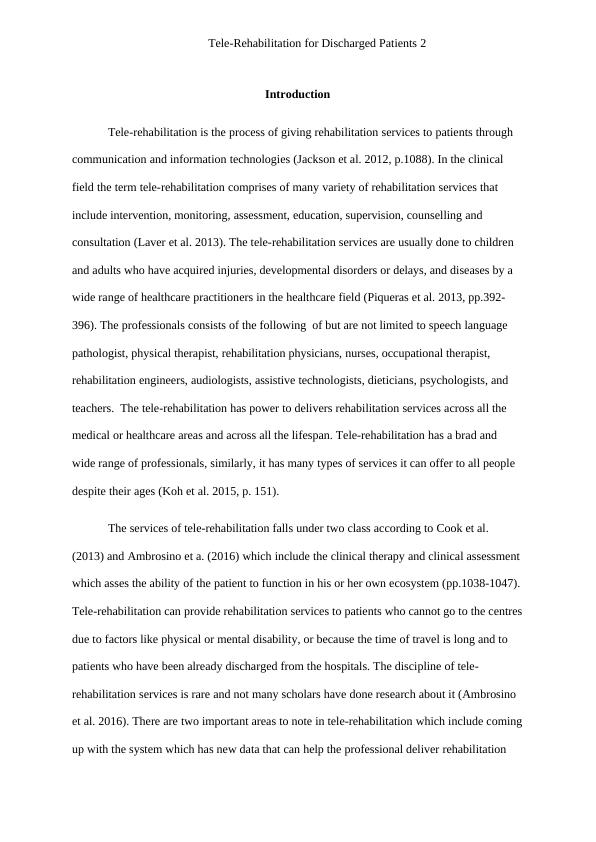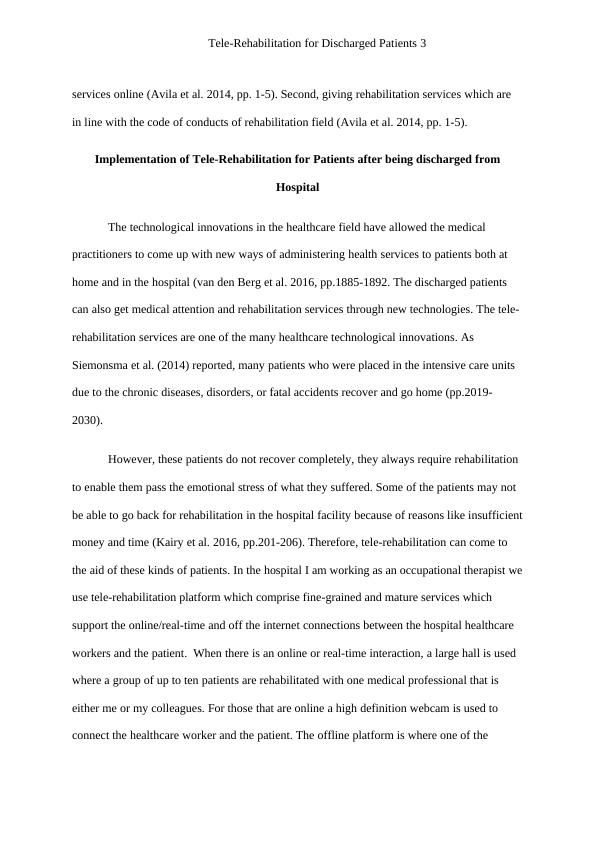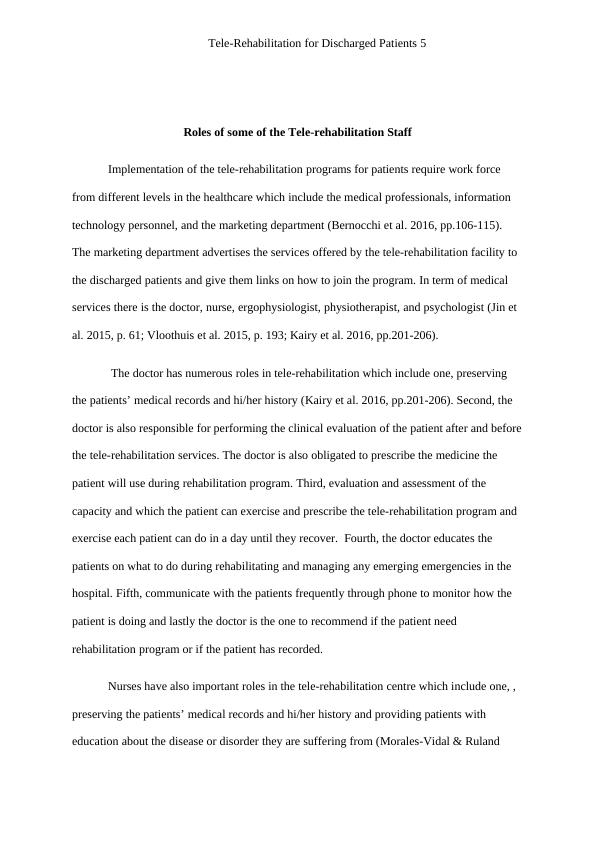Ask a question from expert
The Tele-Rehabilitation Services - PDF
27 Pages7920 Words271 Views
Added on 2021-05-31
The Tele-Rehabilitation Services - PDF
Added on 2021-05-31
BookmarkShareRelated Documents
Tele-Rehabilitation for Discharged Patients 1Tele-Rehabilitation for Discharged PatientsBy [Name]CourseProfessors’ NameInstitutionLocation of InstitutionDate

Tele-Rehabilitation for Discharged Patients 2IntroductionTele-rehabilitation is the process of giving rehabilitation services to patients through communication and information technologies (Jackson et al. 2012, p.1088). In the clinical field the term tele-rehabilitation comprises of many variety of rehabilitation services that include intervention, monitoring, assessment, education, supervision, counselling and consultation (Laver et al. 2013). The tele-rehabilitation services are usually done to children and adults who have acquired injuries, developmental disorders or delays, and diseases by a wide range of healthcare practitioners in the healthcare field (Piqueras et al. 2013, pp.392-396). The professionals consists of the following of but are not limited to speech language pathologist, physical therapist, rehabilitation physicians, nurses, occupational therapist, rehabilitation engineers, audiologists, assistive technologists, dieticians, psychologists, and teachers. The tele-rehabilitation has power to delivers rehabilitation services across all the medical or healthcare areas and across all the lifespan. Tele-rehabilitation has a brad and wide range of professionals, similarly, it has many types of services it can offer to all people despite their ages (Koh et al. 2015, p. 151). The services of tele-rehabilitation falls under two class according to Cook et al. (2013) and Ambrosino et a. (2016) which include the clinical therapy and clinical assessment which asses the ability of the patient to function in his or her own ecosystem (pp.1038-1047). Tele-rehabilitation can provide rehabilitation services to patients who cannot go to the centresdue to factors like physical or mental disability, or because the time of travel is long and to patients who have been already discharged from the hospitals. The discipline of tele-rehabilitation services is rare and not many scholars have done research about it (Ambrosino et al. 2016). There are two important areas to note in tele-rehabilitation which include comingup with the system which has new data that can help the professional deliver rehabilitation

Tele-Rehabilitation for Discharged Patients 3services online (Avila et al. 2014, pp. 1-5). Second, giving rehabilitation services which are in line with the code of conducts of rehabilitation field (Avila et al. 2014, pp. 1-5). Implementation of Tele-Rehabilitation for Patients after being discharged fromHospitalThe technological innovations in the healthcare field have allowed the medical practitioners to come up with new ways of administering health services to patients both at home and in the hospital (van den Berg et al. 2016, pp.1885-1892. The discharged patients can also get medical attention and rehabilitation services through new technologies. The tele-rehabilitation services are one of the many healthcare technological innovations. As Siemonsma et al. (2014) reported, many patients who were placed in the intensive care units due to the chronic diseases, disorders, or fatal accidents recover and go home (pp.2019-2030). However, these patients do not recover completely, they always require rehabilitation to enable them pass the emotional stress of what they suffered. Some of the patients may not be able to go back for rehabilitation in the hospital facility because of reasons like insufficientmoney and time (Kairy et al. 2016, pp.201-206). Therefore, tele-rehabilitation can come to the aid of these kinds of patients. In the hospital I am working as an occupational therapist weuse tele-rehabilitation platform which comprise fine-grained and mature services which support the online/real-time and off the internet connections between the hospital healthcare workers and the patient. When there is an online or real-time interaction, a large hall is used where a group of up to ten patients are rehabilitated with one medical professional that is either me or my colleagues. For those that are online a high definition webcam is used to connect the healthcare worker and the patient. The offline platform is where one of the

Tele-Rehabilitation for Discharged Patients 4medical professional records a rehabilitation processes with a camera and the hospital posts the information in the internet either YouTube or Facebook for patients to view later especially those who missed the online session (Artz et al. 2015, p. 15). Tele-rehabilitation service can be implemented by many healthcare workers in the hospital are at home (Gregersen et al. 2016, p. 809). Personally I administer tele-rehabilitation services at my house through my YouTube channel. For example, when I am showing my patient who needs rehabilitation to walk properly, I record the details of what thepatients need to do by showing example using my assistant show all the steps to be followed and then post the recording in my YouTube channel where my patients will get and watch thevideo. At the hospital in my work place, the exercise is done online where the practitioners show the patients what they need to do in the live feeds. The advantage of using live tele-rehabilitation, there is immediate feedback from the patient. In other words patients and the medical professional interact in real-time. The tele-rehabilitation service can be implemented through many channels for example, blogs and websites (Agostini et al. 2015, pp.202-213; Gregersen et al. 2016, p. 809). I use blog to write to my patients on what they need to do to overcome certain problem.My hospital also has an official website where they post any information that can help patients recover from emotional and physical stress; the data also help in the rehabilitation process. The gadgets that can be used to implement the tele-rehabilitation services include thesmartphones, tablets, laptops and desktops and using the internet connection (Bernocchi et al.2016, pp.106-115). Artz et al. (2015, p. 15) suggest that the new technological advancements have improved the healthcare services.

Tele-Rehabilitation for Discharged Patients 5Roles of some of the Tele-rehabilitation StaffImplementation of the tele-rehabilitation programs for patients require work force from different levels in the healthcare which include the medical professionals, information technology personnel, and the marketing department (Bernocchi et al. 2016, pp.106-115). The marketing department advertises the services offered by the tele-rehabilitation facility to the discharged patients and give them links on how to join the program. In term of medical services there is the doctor, nurse, ergophysiologist, physiotherapist, and psychologist (Jin et al. 2015, p. 61; Vloothuis et al. 2015, p. 193; Kairy et al. 2016, pp.201-206). The doctor has numerous roles in tele-rehabilitation which include one, preserving the patients’ medical records and hi/her history (Kairy et al. 2016, pp.201-206). Second, the doctor is also responsible for performing the clinical evaluation of the patient after and beforethe tele-rehabilitation services. The doctor is also obligated to prescribe the medicine the patient will use during rehabilitation program. Third, evaluation and assessment of the capacity and which the patient can exercise and prescribe the tele-rehabilitation program and exercise each patient can do in a day until they recover. Fourth, the doctor educates the patients on what to do during rehabilitating and managing any emerging emergencies in the hospital. Fifth, communicate with the patients frequently through phone to monitor how the patient is doing and lastly the doctor is the one to recommend if the patient need rehabilitation program or if the patient has recorded. Nurses have also important roles in the tele-rehabilitation centre which include one, , preserving the patients’ medical records and hi/her history and providing patients with education about the disease or disorder they are suffering from (Morales-Vidal & Ruland

Tele-Rehabilitation for Discharged Patients 62013, pp. 101-107; Miller et al. 2014, pp. 1-5). Second, the nurse do follow up and contact patients either through telephones or any other means of communication to see and assess how the patients are reacting to medication and solve any problem about the tele-rehabilitation that may arise. Similar to doctors, nurses also have the obligation to attend to emergencies. Third, nurses ensure that the patients are qualified for the tele-rehabilitation program by checking all necessary forms provided by the service users. Fourth, the nurses arein charge of the technological fitness equipment. They monitor the equipment to make sure that they are functional and record any arising problem. Lastly, the nurses conduct and take anthropometric measurements after the rehabilitation program is over and before the programstarts.Ergophysiologists are important in that they evaluate and do assessment of the physical ability of the patient to determine if they are qualified for tele-rehabilitation (Sarfo etal. 2017, p. 203; Kizony et al. 2013; Miller et al. 2014, p. 1; Adinolfi et al 2016, p. 40). The ergophysiologists also prescribe the quantity of exercise the patient will undergo and also educate the patients on how to go about the prescribed training program. Lastly, the ergophysiologists monitor how the patients are training and record and recommend the next step for the patients. The psychologist in tele-rehabilitation service gives the patient psychological support and advice. They also recommend if the patient can enrol in rehabilitation program. The psychologists also assess and evaluate the psychological behaviour of the patient and prescribe drugs for him or her. The psychotherapist synchronises the therapy programs the patients are undergoing and maintain the medical records of the patients (Chen, Xiao & De Bellis 2016, p. 74). The psychotherapist reads the patients’ medical report and selects appropriate therapy for them and then adds the therapy exercises in his YouTube account or that of the hospital. The

End of preview
Want to access all the pages? Upload your documents or become a member.
Related Documents
Patient Falls in Inpatient Rehabilitation Healthcare Homeslg...
|10
|1714
|471
Telehealth: Benefits and Limitations of Virtual Medical Serviceslg...
|12
|3457
|180
Collaborative Mental Health Nursing Practice with Healthcarelg...
|10
|2852
|355
Community Care Assignment PDFlg...
|5
|819
|27
Telemedicine and Healthcare Technology Trendslg...
|4
|712
|446
Medical Surgical Nursing: Skills Required for Successful Practicelg...
|7
|1597
|74